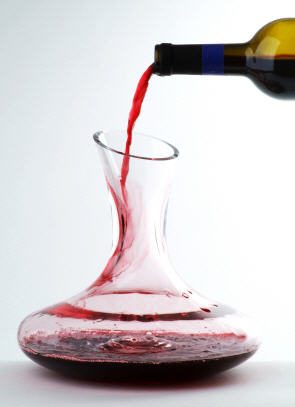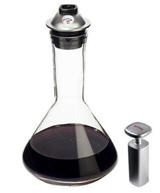

Decanting and the Rules of Terroir
Why we need to decant some wines more than ever.
by
Dan Berger
January 27, 2009
 hances are that the young bottle of wine you recently bought is not ready to drink. Nor will it illustrate what the wine maker knows is really there. To some degree, it is up to you, the buyer, to “fix” the problems.
hances are that the young bottle of wine you recently bought is not ready to drink. Nor will it illustrate what the wine maker knows is really there. To some degree, it is up to you, the buyer, to “fix” the problems.
Wine in the current millennium is vastly different from what it was just 20 or 30 years ago, and a huge part of this is a result of more high-technology entering the wine game, as well as more emphasis on consuming wine before its time, along with the fact that maturity in wine is no longer a primary or even tertiary goal of either wine makers or consumers.
But one of the key factors in all great wine - evidence of the terroir - is easily obliterated early in a wine’s life, and the only way to access it is to decant the wine and allow air to work its magic.
Decanting once was the refuge of the dedicated wine collector as well as wine snob. Sometimes they are the same. Decanting was employed to allow mature wines to open up. The idea was that older wines, cooped up in a confined space for decades, had developed some “off” characteristics and had more to display than just their liquid.
The concept was to allow a bit of aeration to help the wine’s aroma expand, to gain complexity, and to begin the process of softening the tannins so the wine’s aged harmonies could merge with the last vestiges of fresh fruit that once marked the only charm of the wine. In a best-of-all-worlds scenario, the wine still exhibited fruit. Too much aeration for a fragile older wine was, obviously, not a good thing, but other than that little pitfall, decanting was reserved for reds of some age, and almost never used for white wines.
Today the scenario has changed, and more than ever decanting is a vital tool, even for wines that may seem to have little or no terroir character.
And what’s really different is that young white wines and many rosés may be more in need of air than are any of the wines we once routinely decanted. There are various reasons why all of this helps to make wine a lot more enjoyable. In addition, it also may be crucial in accessing regional characteristics in wines that are hidden in their youth.
The Stuff You Need
A Decanter That Saves the Day – and the Wine
Ok, Dan, we now know to decant our wine. But that begs the question: What if you don’t serve all the wine? Up to now there really was no way of preserving what was left in the decanter. That’s where Metrokane’s V1 Vacuum Decanter comes to the rescue: It outfits its handsome, 52-ounce, hand- blown crystal decanter with a rubber stopper and vacuum gauge and a manual vacuum pump. The easy to read vacuum gauge takes the guess-work out of when vacuum seal is obtained, by indicating it with a arrow that moves from a blue to a red or sealed zone.
blown crystal decanter with a rubber stopper and vacuum gauge and a manual vacuum pump. The easy to read vacuum gauge takes the guess-work out of when vacuum seal is obtained, by indicating it with a arrow that moves from a blue to a red or sealed zone.
To see if Metrokane’s claims of wine preservation hold true, I opened a bottle of Alma Rosa Pinot Noir and poured all but a glassful into the decanter. I fastened the tight-fitting top in place, and pushed the vacuum plunger up and down until the gauge on the stopper moved from the blue to the red zone, indicating a tight vacuum seal. The next day I opened a second bottle of the same wine and compared it to the single portion remaining in the first day’s bottle and also to the decanted wine. The single portion no longer had the fragrant bouquet and the wine tasted flat. The decanted wine, when compared to the just opened second bottle, tasted nearly the same. I love it when leftovers don’t taste left over. With the V1, wine lovers can have their wine and drink it too.
(Metrokane V1 Decanter, www.metrokane.com, $80 list, $55 Amazon.com)
Vinturi Wine Aerator Ages Wine in a Flash
It looks like one of those clear, acrylic objet d’arts you see in modern art museum stores. Its stylized and sensuous bullet shape might have you fooled at first glance – what is it? A sea salt dispenser? A martial aid? No, the Vinturi Wine Aerator, for all its surface beauty, has a nobler mission: To instantly decant wine (young or old), doing in seconds what years of cellar aging has up to now required.
Okay, I was just a tad skeptical that such a simple device could replace what wine makers have spent centuries perfecting. In a blind test, we poured an expensive Napa Cabernet Sauvignon (over $100) and an inexpensive Monterey  Pinot Noir (under $10) into two glasses. We then poured the same wines into two other glasses, using the Vinturi. The pairs of wines were presented with the question “Which of each pair do you like better?”
Pinot Noir (under $10) into two glasses. We then poured the same wines into two other glasses, using the Vinturi. The pairs of wines were presented with the question “Which of each pair do you like better?”
The tasters, who have been professional wine judges for years, were surprised to learn that the wine in each glass was from the same bottle. The Vinturi-processed wine was favored each time. The Cabernet, which as originally poured was harsh and tannic, was quite a bit softer and more accessible to the palate after being poured through the Vinturi. The under-ten-dollar Pinot Noir tasted more refined and smoother after its run-in with Vinturi. Each time the device added a better bouquet, better flavors, and a smoother finish.
So just how is this wine improvement accomplished? The scientific answer is that it applies Bernoulli’s principle – as the speed of a moving fluid increases, the pressure within the fluid decreases. So the Vinturi uses the pressure difference to draw in air, which when mixed with wine produces just the right amount of aeration. You might be able to duplicate this by swirling wine in your glass for ten minutes, but the arty Vinturi achieves the same thing faster than a bee sting. You simply pour the wine from a bottle into the oversized shot glass-like reservoir, and listen to the wine gurgle as its gets instantly aerated and splashes into the glass below.
So here’s a Cabernet toast to Rio Sabadicci, Vinturi’s inventor, for creating a product which actually lives up to its hype of enhancing wine enjoyment. Pour us another.
(www.vinturi.com, $40 list, $33.89 Amazon.com)
~ Michael S. Lasky
Three major factors in today’s wine are different from what they were just a couple of decades ago. For one thing, grapes are being picked later than ever, leading to higher alcohols on average. This is true for all wine, and leads to fatter, richer textures.
Secondly, such later picking produces wines with lower acidity (and consequently higher pH levels), which leads to even softer tastes. Yes, California wine makers usually add acid to help balance their wines, but under some conditions, adding acid does not lead to a lower pH (needed for better balance and more stability), and thus many










 READER FEEDBACK: To post your comments on this story,
READER FEEDBACK: To post your comments on this story,





